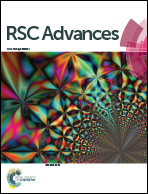Design, synthesis and mode of action of some benzothiazole derivatives bearing an amide moiety as antibacterial agents
Abstract
In this study ten benzothiazole derivatives bearing the amide moiety were designed, synthesized and evaluated for their antibacterial activity and possible mode of action. Structures of the synthesized compounds were elucidated by spectral data. Four different Gram-negative and two different Gram-positive bacterial strains were used in antibacterial activity tests. Among all the synthesised compounds, compound A07 displayed the most potent inhibitory activity with minimum inhibitory concentration (MIC) values of 15.6, 7.81, 15.6, 3.91 µg ml−1 against S. aureus, E. coli, S. typhi and K. pneumoniae respectively. Structure–activity relationship (SAR) studies revealed that electronic and lipophillic factors of the phenyl ring had a significant effect on the antimicrobial activity of the designed compounds. The benzothiazole bearing amide (A01–A10) series exhibited different modes of action based on aryl group substitution as revealed by studies on intact bacterial cells and plasmid DNA. The present study provides us two active compounds (A07 and A10) with a membrane perturbing mode of action, and an intracellular mode of action due to binding with DNA along with potent activity against clinically relevant pathogens E. coli and S. aureus.


 Please wait while we load your content...
Please wait while we load your content...